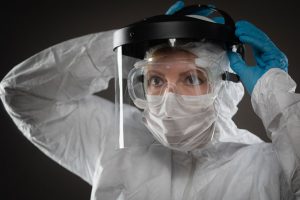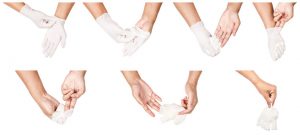PPE use in line with the CDC Standard Precautions is old hat for most nurses. With a disease as infectious as COVID-19 running around, however, it’s both a good time for a refresher and for everyone to up their PPE game.
Fit testing before seeing suspected COVID-19 patients involves ensuring your skin and face are covered as much as possible. More importantly, masks and respirators need to be fitted properly to form a seal to ensure you don’t breathe in any droplets that could be carrying SARS-CoV-2.
Respirators are fitted properly if the seal around the nose and mouth can be maintained. A formal test should be performed using chemical or sensor checks the first time you put on a new respirator, and a basic seal check should happen at each use thereafter.
Avoiding cross contamination from PPE largely comes down to the sequence in which it’s put on and removed:
Putting On PPE
- Don gown
- Don mask
- Goggles and face shield
- Don gloves
Removing PPE
- Doff gloves
- Doff gown
- Doff Goggles and face shield
- Doff mask
How To Check Your Personal Protective Equipment Fit Before Treating COVID-19 Patients

For the most part, PPE fit for nurses involves trying on the three to six general sizes of equipment that are available once, and then sticking with it for the rest of your career.
With the shortages we’re experiencing now with COVID-19 demand overwhelming supply chains, your preferred sizes may not always be available. But there’s no procedure yet invented that will squeeze extra-large hands into extra small gloves. For items like gowns, you can sometimes double up, using one worn in front and one in back for complete coverage. But many nurses have had to resort to improvised coverage using garbage bags or other impermeable barriers. There’s no fit like a custom fit.
The area where improvising and improper sizing can be a real barrier, however, is with respirators.
Checking Respirator Fit and Seal
Fit tests are conducted in accordance with brand/make/model-specific instructions. Although this is usually a once-a-year requirement, per OSHA, the ad hoc nature of respirator supply may result in a hodgepodge of equipment that you will have to make use of right now. Additionally, many facilities are being forced to sterilize and re-use disposable respirators under emergency FDA authorization. A fit test is recommended before every use of a sterilized respirator.
PAPRs, or Powered Air-Purifying Respirators, may be exempt from this requirement depending on their design—those that are simply hoods or helmets that rely on positive pressure rather than an air seal do not need to be fit-checked.
There are two types of fit tests:
- Qualitative – A simple pass/fail test that relies on the wearer detecting, or not, a test agent with a smell that should not reach the nose if the respirator fits properly
- Quantitative – A test that uses an instrument to check the effectiveness of the seal and filtration
The following technique gives you the best chance at having the fitment pass the test:
- No facial hair should protrude beyond the edges of the respirator
- The device should fit under chin and over nose
- Use a mirror to check coverage if you are doing the check yourself
Once the mask is on, you can perform the fit check to verify that it is working properly.
A user seal check is a simpler procedure that you need to perform every time you don the respirator. It simply requires either exhaling or inhaling while blocking the designed paths for air ingress/egress. If air escapes or comes in other than through those paths, the seal is no good. Most manufacturers have specific seal test procedures; not all can be checked through both methods, so consult those recommendations to find the right steps for your gear.
Properly Donning and Doffing PPE For Patient and Provider Safety

A good fit relies on proper donning procedure each time you put on PPE. Consistency is important, and well-established procedures have been created to help you through the process. While these aren’t new to anyone in healthcare, many providers become lax with their technique after years of working in the pre-pandemic world; a 2019 study found that 36 percent of healthcare workers came away from visits with infectious clients with contamination on hands, clothes, or equipment after improperly wearing or doffing PPE.
Donning For Complete Protection From COVID-19 Exposure
Don PPE before patient contact, and, if possible, before entering the patient room. Many COVID-19 treatment facilities are creating dedicated donning/doffing stations as a way to provide a single point of supply stocks and to minimize the occurrence of nurses and other healthcare workers moving around in contaminated gear.
The order in which you put on the gear is important. For the full ensemble required for COVID-19 protection, use the following steps:
- Don gown
- Secure at the neck and waist
- Don mask
- Cup respirator in hand and place over face
- Pull straps into place; one on the upper back of the head, one below the ears at the base of the neck
- Adjust nose piece to conform to the bridge of your nose, with special attention to a symmetrical fit
- Goggles and face shield
- Put goggles on and secure to the head
- Position face shield over the face and secure across the brow with headband; adjust for comfort
- Don gloves
- Extend hands into gloves and extend gloves over the wrists of the gown
- Tuck the cuffs of the gown securely under the glove
- Adjust for comfort and dexterity
Remove PPE Carefully to Avoid Contamination
The overall goal when taking your PPE off is to avoid contaminating yourself or the environment around you. A disposal safe bin should be immediately at hand in which to put the discarded gear. As with donning, doffing is best performed outside patient rooms, in a dedicated space or well-defined doffing station.
- Doff gloves
- Grab outside edge near the wrist
- Peel away from the hand, turning inside out as you go, with opposite glove
- Slid ungloved finger under wrist of remaining globe, then peel off from the inside, bagging both gloves in the process
- Doff gown
- Unfasten ties
- Peel away from neck and shoulder
- Turn outside in
- Fold into a bundle and discard
- Doff Goggles and face shield
- Grasp ear pieces of head band and lift off
- Doff mask
- Take off bottom, then top; be careful about snapping elastic restraints
- Lift away from face
Normally, the step after removing each item is to place it in a disposal receptacle. However, with PPE re-use becoming increasingly common, your facility may have other steps for you to perform to avoid damaging items and preparing them for further sterilization.
Avoid touching the exterior of your protective gear; it may be coated, after all, in whatever you are trying to protect yourself from.
Using a Spotter While Donning or Doffing PPE
The CDC calls these personnel Trained Observers. In normal times, they are clinicians, and often infection control specialists, but in the current environment, any staff trained to perform the role may be filling in.
Spotters can directly assist providers in the donning process, ensuring that all items are put on and fitted properly and secured for patient contact. They ensure items are put on in the proper order and that all necessary equipment is in place.
During doffing, the spotter literally just spots, and typically from a safe distance (6 feet or more). The goal during doffing is also to guide the provider through the proper steps and techniques for removing contaminated gear, but also to spot any issues—a torn glove, a mistaken point of contact when removing goggles—that might require immediate and additional decontamination before proceeding.
Just like the provider putting on or removing the gear, a spotter should perform hand hygiene before and after the process is complete.


